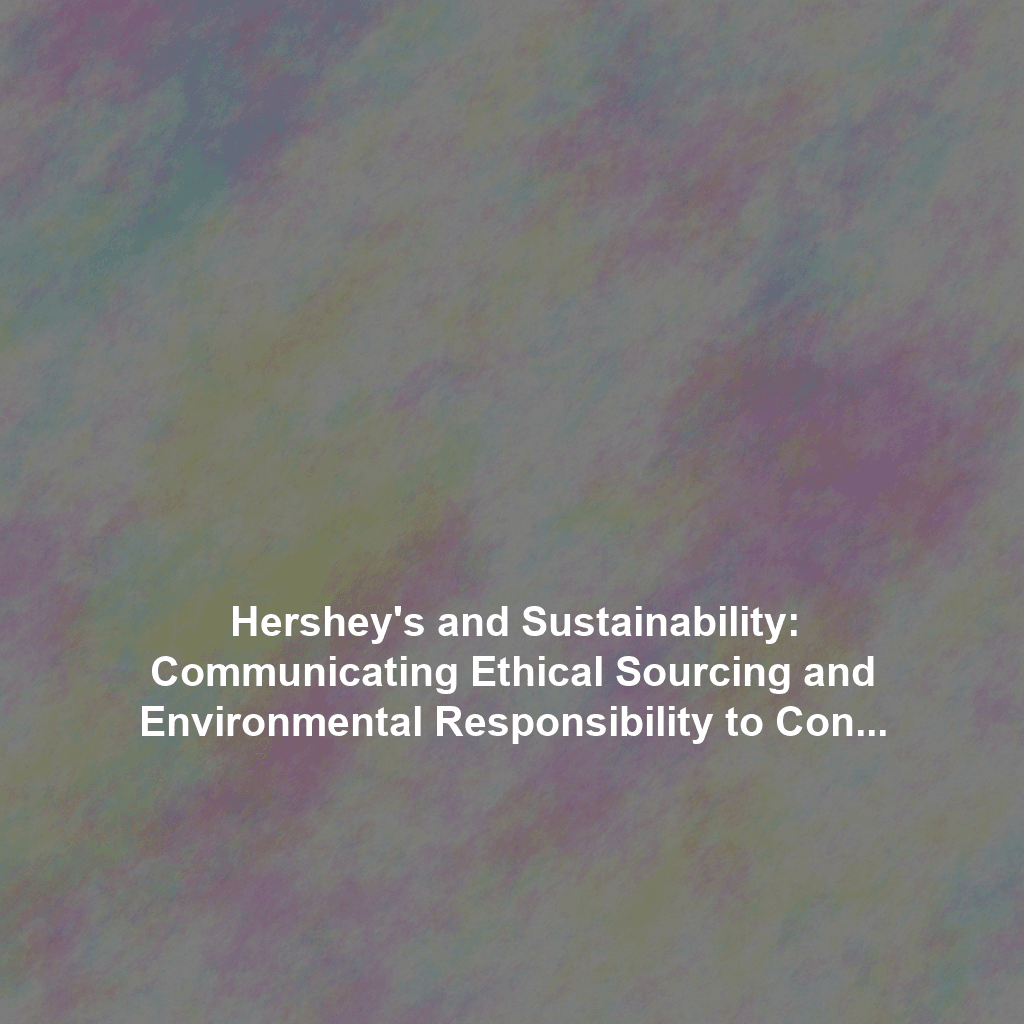Hershey’s, an iconic American chocolate brand, has been a household name for generations. But in today’s world, simply offering delicious chocolate isn’t enough. Consumers are increasingly demanding transparency and accountability from the brands they support, particularly regarding ethical sourcing and environmental responsibility. This article dives deep into how Hershey’s communicates its sustainability initiatives, examining its efforts to address crucial issues in cocoa production and minimize its environmental footprint, all while navigating the delicate balance of marketing and genuine impact.
The Sweet Spot of Sustainability: Why It Matters to Hershey’s
For Hershey’s, embracing sustainability isn’t just a trend; it’s a strategic imperative. A growing segment of consumers actively seek out brands that align with their values, making sustainability a key differentiator in the competitive chocolate market. Beyond consumer demand, addressing issues like child labor in cocoa farming and the environmental impact of production is crucial for the long-term viability of the cocoa supply chain and the well-being of the communities that depend on it.
Ethical Cocoa Sourcing: Tackling the Complexities
Cocoa For Good: Hershey’s Sourcing Commitment
Hershey’s has launched initiatives like Cocoa For Good, a comprehensive program aimed at addressing ethical concerns in cocoa production. These initiatives typically focus on farmer training, community development, and child labor monitoring and remediation. The program focuses on farmer livelihood improvement, preventing child labor, and protecting the environment.
Transparency and Traceability: Shining a Light on the Supply Chain
One of the biggest challenges in ethical sourcing is ensuring traceability throughout the complex cocoa supply chain. Hershey’s attempts to achieve this through partnerships with certification organizations like Fairtrade and UTZ (now part of the Rainforest Alliance). While certification helps, it’s important to note the limitations. Independent audits and robust monitoring systems are essential for verifying claims and ensuring compliance with ethical standards. Hershey’s is striving to increase the amount of cocoa sourced from certified and traceable sources.
Communicating the Progress (and the Challenges)
Hershey’s communicates its progress on ethical sourcing through its website, annual sustainability reports, and marketing campaigns. However, transparency isn’t just about reporting successes; it’s also about acknowledging challenges and outlining concrete steps to address them. For example, openly discussing the ongoing efforts to eliminate child labor, even if complete eradication is a long-term goal, can build more trust with consumers than simply highlighting positive achievements. Hershey has invested significant resources in building systems that help prevent and remediate child labor in its supply chains.
Reducing Environmental Impact: From Bean to Bar
Sustainable Farming Practices: Protecting the Environment
Cocoa farming can have significant environmental impacts, including deforestation and soil degradation. Hershey’s promotes sustainable farming practices among its suppliers, such as agroforestry (integrating trees into farming systems), which helps improve soil health, conserve biodiversity, and sequester carbon. Hershey’s is working to promote climate-smart agricultural practices across its supply chain.
Packaging and Waste Reduction: Minimizing the Footprint
Beyond the cocoa farms, Hershey’s is also focused on reducing its environmental footprint through packaging innovation and waste reduction initiatives. This includes exploring more sustainable packaging materials, reducing packaging weight, and promoting recycling. While progress has been made, the use of plastics in chocolate packaging remains a challenge. Hershey’s actively invests in research and development of alternative packaging solutions.
Energy Efficiency and Carbon Emissions: Working Towards a Smaller Footprint
Hershey’s is also committed to reducing its energy consumption and greenhouse gas emissions throughout its operations. This includes investing in energy-efficient equipment, utilizing renewable energy sources, and optimizing its supply chain to reduce transportation emissions. Hershey has set aggressive targets for reducing its greenhouse gas emissions and water usage.
Assessing the Authenticity and Effectiveness of Hershey’s Sustainability Messaging
The effectiveness of Hershey’s sustainability marketing hinges on its authenticity. Consumers are increasingly savvy and can quickly spot “greenwashing”—the practice of exaggerating or falsely claiming environmental benefits. To avoid this, Hershey’s must ensure that its messaging is backed by tangible actions and verifiable data. Transparency in reporting progress, acknowledging challenges, and engaging with stakeholders are crucial for building credibility. Third-party certifications and independent audits can also help validate claims and build trust.
Recommendations for Improvement: Sweetening the Deal
While Hershey’s has made significant strides in its sustainability journey, there’s always room for improvement. Here are some recommendations:
- Enhanced Transparency: Provide more detailed information about the specific actions being taken to address ethical and environmental challenges. This includes sharing data on farmer incomes, child labor remediation efforts, and the environmental impact of cocoa production.
- Deeper Stakeholder Engagement: Engage more actively with cocoa farmers, local communities, and NGOs to ensure that sustainability initiatives are truly beneficial and address their needs.
- Strengthened Supply Chain Monitoring: Invest in more robust monitoring and verification systems to ensure that ethical and environmental standards are being consistently met throughout the entire cocoa supply chain.
- Innovation in Packaging: Accelerate the development and adoption of truly sustainable packaging solutions, such as compostable or biodegradable materials.
- Communicating with Empathy and Honesty: Present sustainability initiatives not as a marketing ploy, but as a core value of the company. Acknowledge challenges openly and demonstrate a genuine commitment to continuous improvement.
- Support for Farmer Livelihoods: Increased investments in programs that enhance farmer livelihoods are crucial for addressing the root causes of child labor and poverty in cocoa-growing regions.
Conclusion: A Journey Towards a Sustainable Future for Chocolate
Hershey’s journey towards sustainability is an ongoing process. By prioritizing ethical sourcing, reducing its environmental impact, and communicating its efforts with transparency and authenticity, Hershey’s can build trust with consumers and contribute to a more sustainable future for the chocolate industry. The key is to view sustainability not just as a marketing strategy, but as a fundamental commitment to responsible business practices and the well-being of the communities and environment it depends on. As consumer expectations continue to evolve, Hershey’s must remain vigilant in its efforts to meet these demands and lead the way in creating a more sustainable and ethical chocolate supply chain.
 Skip to content
Skip to content

